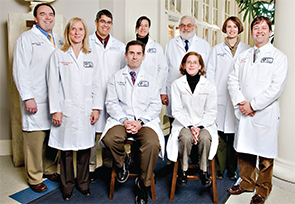
Dr. Dellaripa and Dr. Goldberg (seated), co-directors of the Interstitial Lung Disease Clinic, with additional staff members.
Co-morbidities in patients with rheumatoid arthritis and related autoimmune diseases often warrant a multidisciplinary approach to treatment. When it comes to inflammatory and fibrotic lung conditions in these patients, collaboration between pulmonary/critical care specialists and rheumatologists is essential, say two rheumatologists recently interviewed by The Rheumatologist. Both followed their rheumatology fellowship training with additional fellowships in critical care medicine. Their reasons for combining the two specialties are particular to each physician, although they both share the drive to improve their patients’ complicated co-disorders.
Capacity to Influence & Guide Care
“If you look at some of the data for lung diseases associated with the rheumatic diseases, the mortality associated with these patients approaches some types of cancer,” notes Paul F. Dellaripa, MD, co-director of the Interstitial Lung Disease Clinic and associate professor of medicine at Harvard Medical School and Brigham and Women’s Hospital, Boston. “The five-year mortality for lung disorders, such as RA or dermatomyositis, is quite high,” says Dr. Dellaripa.
Dr. Dellaripa’s choice to follow his rheumatology fellowship at Tufts University School of Medicine with one in critical care at the Lahey Clinic and Beth Israel Deaconess Medical Center arose from an initial frustration over how his rheumatology patients admitted to the ICU were handled. He had always enjoyed critical care medicine and began to contemplate pursuing an additional fellowship in that discipline. To be sure that it would be a viable career path, he took a year off and worked with another physician in critical care in a community ICU. He reports that although his mentors did not have much direct experience with combining both specialties—and there had not been anyone else pursuing both—“they encouraged me to build a new bridge between two disciplines.”
Dr. Dellaripa then practiced as a rheumatologist and critical care specialist for 11 years at Lahey Clinic, a physician-led nonprofit teaching hospital of Tufts University in Burlington, Mass. “As time went on, I began to see more and more patients whose pulmonary disorders were related primarily to their rheumatologic disease,” he recalls.
When his rheumatology patients became critically ill, he notes that many pulmonary/critical care physicians seemed uncomfortable with, or even unaware of, the unique pulmonary problems his patients presented. That’s when his interests began to shift, he says. He decided to refocus his critical care training, “which had a pulmonary bent,” and moved to Brigham and Women’s to open a lung disease clinic. Combining rheumatology with pulmonary critical care, he reasoned, “would give me the capacity to influence and guide both inpatient and outpatient care.”

